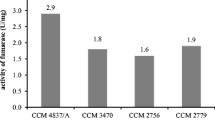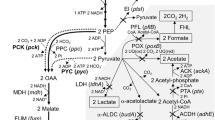Abstract
Accumulation of succinate as a fermentation product of Fusobacterium varium was enhanced when the anaerobic bacterium was grown on complex peptone medium supplemented with fumarate. Residual substrates and fermentation products were determined by proton NMR spectroscopy. Cells collected from the fumarate-supplemented medium (8–10 h after inoculation) supported the conversion of fumarate to succinate when suspended with fumarate and a co-substrate (glucose, sorbitol, or glycerol). Succinate production was limited by the availability of fumarate or reducing equivalents supplied by catabolism of a co-substrate via the Embden-Meyerhof-Parnas (EMP) pathway. The choice of reducing co-substrate influenced the yield of acetate and lactate as side products. High conversions of fumarate to succinate were achieved over pH 6.6–8.2 and initial fumarate concentrations up to 300 mM. However, at high substrate concentrations, intracellular retention of succinate reduced extracellular yields. Overall, the efficient utilization of fumarate (≤ 400 mM) combined with the significant extracellular accumulation of succinate (corresponding to ≥ 70% conversion) indicated the effective utilization of fumarate as a terminal electron acceptor by F. varium and the potential of the methodology for the bioproduction of succinate.





Similar content being viewed by others
References
Jiang, M., Ma, J., Wu, M., Liu, R., Liang, L., Xin, F., Zhang, W., Jia, H., & Dong, W. (2017). Progress of succinic acid production from renewable resources: Metabolic and fermentative strategies. Bioresource Technology, 245, 1710–1717.
Mazière, A., Prinsen, P., García, A., Luque, R., & Len, C. (2017). A review of progress in (bio)catalytic routes from/to renewable succinic acid. Biofuels, Bioproducts & Biorefining, 11(5), 908–931.
Ahn, J. H., Jang, Y.-S., & Lee, S. Y. (2016). Production of succinic acid by metabolically engineered microorganisms. Current Opinion in Biotechnology, 42, 54–66.
Morales, M., Ataman, M., Badr, S., Linster, S., Kourlimpinis, I., Papadokonstantakis, S., Hatzimanikatis, V., & Hungerbühler, K. (2016). Sustainability assessment of succinic acid production technologies from biomass using metabolic engineering. Energy & Environmental Science, 9(9), 2794–2805.
Cao, Y., Zhang, R., Sun, C., Cheng, T., Liu, Y., & Xian, M. (2013). Fermentative succinate production: An emerging technology to replace the traditional petrochemical processes. BioMed Research International. Article ID 723412. https://doi.org/10.1155/2013/723412.
Delhomme, C., Weuster-Botz, D., & Kühn, F. E. (2009). Succinic acid from renewable resources as a C4 building-block chemical—A review of the catalytic possibilities in aqueous media. Green Chemistry, 11(1), 13–26.
Cukalovic, A., & Stevens, C. V. (2008). Feasibility of production methods for succinic acid derivatives: A marriage of renewable resources and chemical technology. Biofuels, Bioproducts & Biorefining, 2(6), 505–529.
Bechthold, I., Bretz, K., Kabasci, S., Kopitzky, R., & Springer, A. (2008). Succinic acid: A new platform chemical for biobased polymers from renewable resources. Chemical Engineering & Technology, 31(5), 647–654.
McKinlay, J. B., Vieille, C., & Zeikus, J. G. (2007). Prospects for a bio-based succinate industry. Applied Microbiology and Biotechnology, 76(4), 727–740.
Jansen, M. L. A., & van Gulik, W. M. (2014). Towards large scale fermentative production of succinic acid. Current Opinion in Biotechnology, 30, 190–197.
Debabov, V. G. (2015). Prospects for biosuccinic acid production. Applied Biochemisty and Microbiology, 51(8), 787–791.
Besson, M., Gallezot, P., & Pinel, C. (2014). Conversion of biomass into chemicals over metal catalysts. Chemical Reviews, 114(3), 1827−1870.
Zhu, L.-W., & Tang, Y.-J. (2017). Current advances of succinate biosynthesis in metabolically engineered Escherichia coli. Biotechnology Advances, 35(8), 1040–1048.
Beauprez, J. J., De Mey, M., & Soetaert, W. K. (2010). Microbial succinic acid production: Natural versus metabolic engineered producers. Process Biochemistry, 45(7), 1103–1114.
Chen, Y., & Nielsen, J. (2016). Biobased organic acids production by metabolically engineered microorganisms. Current Opinion in Biotechnology, 37, 165–172.
Thakker, C., Martínez, I., San, K.-Y., & Bennett, G. N. (2012). Succinate production in Escherichia coli. Biotechnology Journal, 7(2), 213–224.
Cheng, K.-K., Wang, G.-Y., Zeng, J., & Zhang, J.-A. (2013). Improved succinate production by metabolic engineering. BioMed Research International. Article ID 538790. https://doi.org/10.1155/2013/538790.
Li, C., Yang, X., Gao, S., Wang, H., & Lin, C. S. K. (2017). High efficiency succinic acid production from glycerol via in situ fibrous bed bioreactor with an engineered Yarrowia lipolytica. Bioresource Technology, 225, 9–16.
Ryu, H.-W., Kang, K.-H., & Yun, J.-S. (1999). Bioconversion of fumarate to succinate using glycerol as a carbon source. Applied Biochemistry and Biotechnology, 78(1–3), 511–520.
Kang, K.-H., Yun, J.-S., & Ryu, H.-W. (2000). Effect of culture conditions on the production of succinate by Enterococcus faecalis RKY1. Journal of Microbiology and Biotechnology, 10(1), 1–7.
Ryu, H.-W., & Wee, Y.-J. (2001). Characterization of bioconversion of fumarate to succinate by alginate immobilized Enterococcus faecalis RKY1. Applied Biochemistry and Biotechnology, 91–93(1–9), 525–535.
Wee, Y.-J., Yun, J.-S., Kang, K.-H., & Ryu, H.-W. (2002). Continuous production of succinic acid by a fumarate-reducing bacterium immobilized in a hollow-fiber bioreactor. Applied Biochemistry and Biotechnology, 98–100(1–9), 1093–1104.
Resmer, K. L., & White, R. L. (2011). Metabolic footprinting of the anaerobic bacterium Fusobacterium varium using 1H NMR spectroscopy. Molecular BioSystems, 7(7), 2220–2227.
Hofstad, T. (2006). The prokaryotes: A Handbook on the Biology of Bacteria. In S. Falkow, E. Rosenberg, & K.-H. Schleifer (Eds.), The genus Fusobacterium (Vol. 7, pp. 1016–1027). New York: Springer.
Ramezani, M., Resmer, K. L., & White, R. L. (2011). Glutamate racemization and catabolism in Fusobacterium varium. The FEBS Journal, 278(14), 2540–2551.
Potrykus, J., White, R. L., & Bearne, S. L. (2008). Proteomic investigation of amino acid catabolism in the indigenous gut anaerobe Fusobacterium varium. Proteomics, 8(13), 2691–2703.
Potrykus, J., Mahaney, B., White, R. L., & Bearne, S. L. (2007). Proteomic investigation of glucose metabolism in the butyrate-producing gut anaerobe Fusobacterium varium. Proteomics, 7(11), 1839–1853.
Ramezani, M., & White, R. L. (2011). Enantioselective catabolism of racemic serine: Preparation of d-serine using whole cells of Fusobacterium nucleatum. Tetrahedron: Asymmetry, 22(13), 1473–1478.
LeBlanc, L. M., Powers, S. W., Grossert, J. S., & White, R. L. (2016). Competing fragmentation processes of β-substituted propanoate ions upon collision-induced dissociation. Rapid Communications in Mass Spectrometry, 30(19), 2133–2144.
Sekizuka, T., Ogasawara, Y., Ohkusa, T., & Kuroda, M. (2017). Characterization of Fusobacterium varium Fv113-g1 isolated from a patient with ulcerative colitis based on complete genome sequence and transcriptome analysis. PLoS One, 12(12), e0189319.
F. varium genomes. Available from https://www.ncbi.nlm.nih.gov/protein/. Accessed 5 March 2018.
Li, Q.-Z., Jiang, X.-L., Feng, X.-J., Wang, J.-M., Sun, C., Zhang, H.-B., Xian, M., & Liu, H.-Z. (2016). Recovery processes of organic acids from fermentation broths in the biomass-based industry. Journal of Microbiology and Biotechnology, 26(1), 1–8.
Doelle, H. W. (1975). Bacterial metabolism (2nd ed.pp. 269–270). New York: Academic Press.
Clomburg, J. M., & Gonzalez, R. (2013). Anaerobic fermentation of glycerol: A platform for renewable fuels and chemicals. Trends in Biotechnology, 31(1), 20–28.
Khanna, S., Goyal, A., & Moholkar, V. S. (2012). Microbial conversion of glycerol: Present status and future prospects. Critical Reviews in Biotechnology, 32(3), 235–262.
Lancaster, C. R. D. (2001). Succinate:Quinone oxidoreductases – What can we learn from Wolinella succinogenes quinol:Fumarate reductase? FEBS Letters, 504(3), 133–141.
Chung, S.-C., Park, J.-S., Yun, J., & Park, J. H. (2017). Improvement of succinate production by release of end-product inhibition in Corynebacterium glutamicum. Metabolic Engineering, 40, 157–164.
Acknowledgements
This research was funded by the Natural Sciences and Engineering Research Council of Canada (NSERC grant RGPIN/04536-2014). NMR and mass spectra were collected on instruments provided by NMR-3 and the Mass Spectrometry Laboratory, respectively (Dalhousie University).
Author information
Authors and Affiliations
Corresponding author
Ethics declarations
Conflict of Interest
The authors declare that they have no conflicts of interest.
Electronic Supplementary Material
ESM 1
(DOCX 114 kb)
Rights and permissions
About this article
Cite this article
McDonald, N.C., White, R.L. Reduction of Fumarate to Succinate Mediated by Fusobacterium varium. Appl Biochem Biotechnol 187, 163–175 (2019). https://doi.org/10.1007/s12010-018-2817-0
Received:
Accepted:
Published:
Issue Date:
DOI: https://doi.org/10.1007/s12010-018-2817-0




